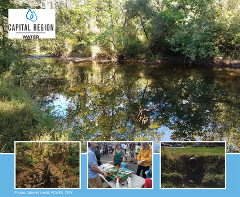Capital Region Water Makes Environmental Impact with Collaborative Watershed Approach
 Capital Region Water (CRW) in Harrisburg, Pennsylvania and two upstream neighboring municipalities, Lower Paxton Township (LPT) and Susquehanna Township (ST), joined forces as the Paxton Creek Cooperative, committed to working together on a Joint Pollutant Reduction Plan (PRP) to reduce sediment from stormwater discharges and stream bank erosion and improve the health of Paxton Creek, Beaver Creek, Spring Creek, and the Chesapeake Bay. The approach outlined in the Paxton Creek Strategy, which includes the Paxton Creek Watershed Total Maximum Daily Load (TMDL) Plan, the Chesapeake Bay PRP, the Wildwood Lake PRP, and the Unnamed Tributary (UNT) Spring Creek PRP is the basis of this Joint Plan. The Cooperative started the joint planning in 2015 with an intergovernmental cooperation agreement (IGA) to develop a comprehensive strategy to address water quality requirements and implement the strategy watershed-wide. In August 2020, the Paxton Creek Cooperative received approval for the Joint PRP and the partners’ MS4 Individual Permits from Pennsylvania Department of Environmental Protection (PADEP).
Capital Region Water (CRW) in Harrisburg, Pennsylvania and two upstream neighboring municipalities, Lower Paxton Township (LPT) and Susquehanna Township (ST), joined forces as the Paxton Creek Cooperative, committed to working together on a Joint Pollutant Reduction Plan (PRP) to reduce sediment from stormwater discharges and stream bank erosion and improve the health of Paxton Creek, Beaver Creek, Spring Creek, and the Chesapeake Bay. The approach outlined in the Paxton Creek Strategy, which includes the Paxton Creek Watershed Total Maximum Daily Load (TMDL) Plan, the Chesapeake Bay PRP, the Wildwood Lake PRP, and the Unnamed Tributary (UNT) Spring Creek PRP is the basis of this Joint Plan. The Cooperative started the joint planning in 2015 with an intergovernmental cooperation agreement (IGA) to develop a comprehensive strategy to address water quality requirements and implement the strategy watershed-wide. In August 2020, the Paxton Creek Cooperative received approval for the Joint PRP and the partners’ MS4 Individual Permits from Pennsylvania Department of Environmental Protection (PADEP).
In 2019, the Paxton Creek Cooperative built a partnership with the Pennsylvania Department of Transportation (PennDOT) to execute the first of many stream restoration projects that will effectively reduce sediment erosion and achieve our targeted total suspended solids (TSS) reduction requirements under the Paxton Creek TMDL. PennDOT holds a state-wide MS4 Permit under which they are encouraged to work with municipalities across the Commonwealth to implement stormwater projects by receiving shared pollutant load reductions. The Paxton Creek Watershed Sediment Reduction Project with PennDOT is currently underway.
The Paxton Creek Cooperative, with an updated Intergovernmental Cooperation Agreement in place, plans to execute multiple watershed-wide projects over the next 5 years to achieve the environmental goals outlined above. As noted, the initial series of projects under design and implementation through the PennDOT partnership will accelerate the watershed-wide pollutant load reduction goals. This collaborative watershed approach is also on track to be the most cost-effective method to reducing pollutant loads and improving water quality.
For this notable, collaborative project, Capital Region Water was recognized with a NACWA 2021 National Environmental Achievement Award in the Watershed Collaboration category. Congratulations to Capital Region Water and everyone involved!